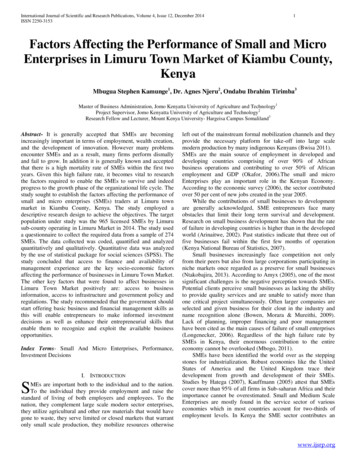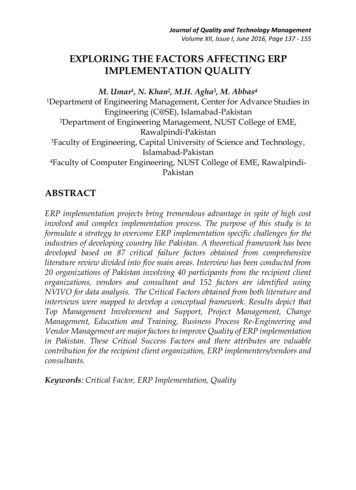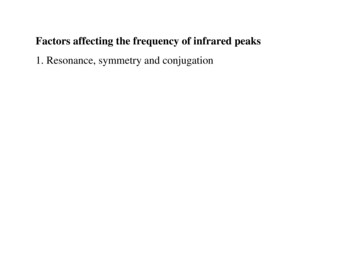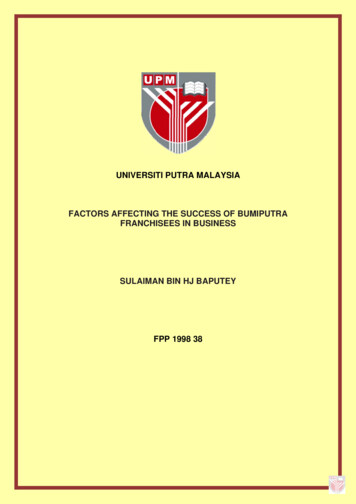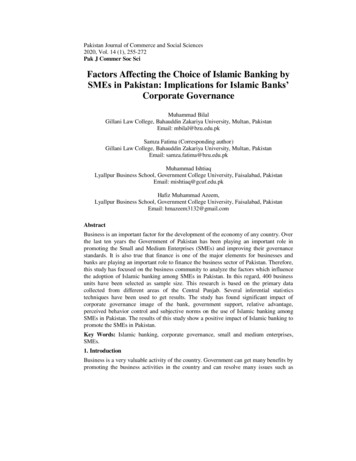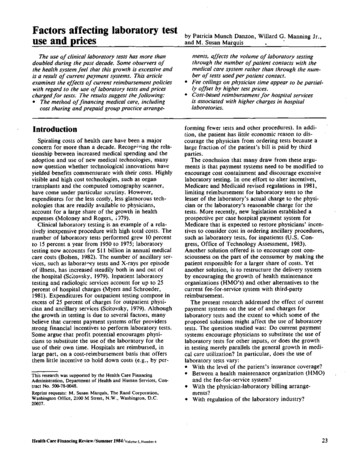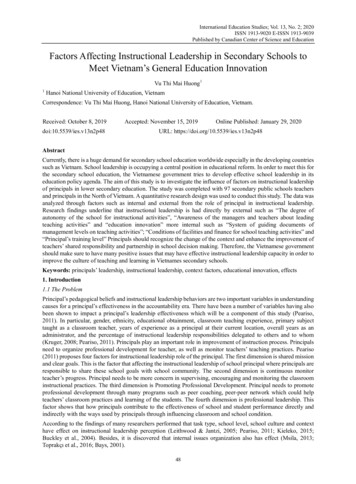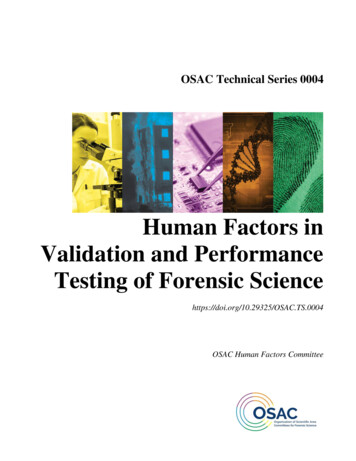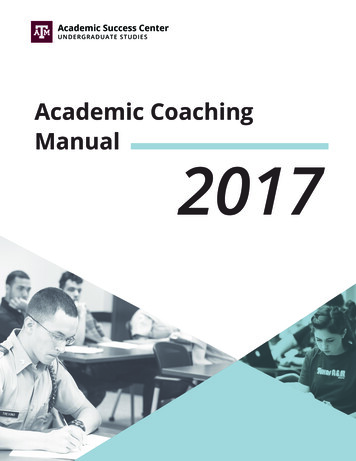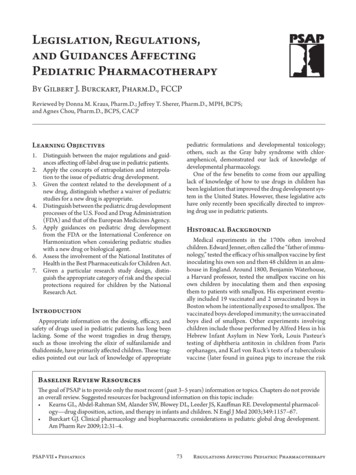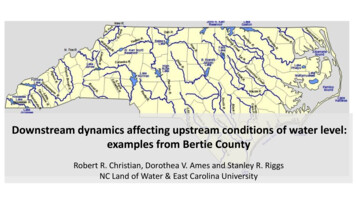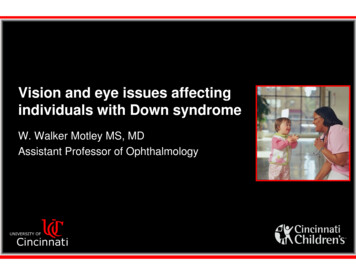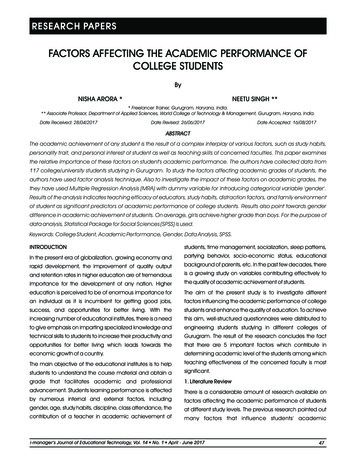
Transcription
RESEARCH PAPERSFACTORS AFFECTING THE ACADEMIC PERFORMANCE OFCOLLEGE STUDENTSByNISHA ARORA *NEETU SINGH *** Freelancer Trainer, Gurugram, Haryana, India.** Associate Professor, Department of Applied Sciences, World College of Technology & Management, Gurugram, Haryana, India.Date Received: 28/04/2017Date Revised: 26/06/2017Date Accepted: 16/08/2017ABSTRACTThe academic achievement of any student is the result of a complex interplay of various factors, such as study habits,personality trait, and personal interest of student as well as teaching skills of concerned faculties. This paper examinesthe relative importance of these factors on student's academic performance. The authors have collected data from117 college/university students studying in Gurugram. To study the factors affecting academic grades of students, theauthors have used factor analysis technique. Also to investigate the impact of these factors on academic grades, thethey have used Multiple Regression Analysis (MRA) with dummy variable for introducing categorical variable 'gender'.Results of the analysis indicates teaching efficacy of educators, study habits, distraction factors, and family environmentof student as significant predictors of academic performance of college students. Results also point towards genderdifference in academic achievement of students. On average, girls achieve higher grade than boys. For the purpose ofdata analysis, Statistical Package for Social Sciences (SPSS) is used.Keywords: College Student, Academic Performance, Gender, Data Analysis, SPSS.INTRODUCTIONstudents, time management, socialization, sleep patterns,In the present era of globalization, growing economy andpartying behavior, socio-economic status, educationalrapid development, the improvement of quality outputbackground of parents, etc. In the past few decades, thereand retention rates in higher education are of tremendousis a growing study on variables contributing effectively toimportance for the development of any nation. Higherthe quality of academic achievement of students.education is perceived to be of enormous importance forThe aim of the present study is to investigate differentan individual as it is incumbent for getting good jobs,factors influencing the academic performance of collegesuccess, and opportunities for better living. With thestudents and enhance the quality of education. To achieveincreasing number of educational institutes, there is a needthis aim, well-structured questionnaires were distributed toto give emphasis on imparting specialized knowledge andengineering students studying in different colleges oftechnical skills to students to increase their productivity andGurugram. The result of the research concludes the factopportunities for better living which leads towards thethat there are 5 important factors which contribute ineconomic growth of a country.determining academic level of the students among whichThe main objective of the educational institutes is to helpteaching effectiveness of the concerned faculty is moststudents to understand the course material and obtain asignificant.grade that facilitates academic and professional1. Literature Reviewadvancement. Students learning performance is affectedThere is a considerable amount of research available onby numerous internal and external factors, includingfactors affecting the academic performance of studentsgender, age, study habits, discipline, class attendance, theat different study levels. The previous research pointed outcontribution of a teacher in academic achievement ofmany factors that influence students' academici-manager’s Journal of Educational Technology, Vol. 14 lNo. 1 lApril - June 201747
RESEARCH PAPERSachievement.performance in higher education as friends having similarStudent's academic performance may be influenced byfuture plans get inspired by each other and perform bettertheir faculty's attributes as they interact closely with their(Yousuf et al. 2011).lecturers in their day-to-day interactions. The presentationSocio-Economic Status (SES) and education of parentsof the module content by the concerned instructor shouldhave a significant role in the overall academicbe made considering the interests of the students, As theachievement of the students (Farooq et al., 2011). He alsoattitude and motivation towards a module may beconcluded that girl students perform better than the maleinfluenced by the way in which module content isstudents. Educated parents can better communicatepresented to student (Sikhwari, et al., 2015). He also statedregarding academic activities and assist them in their workthat there should be respect and trust in the interactions(Fantuzzo et al., 2000; Trusty, 1999). So the academicbetween students and the faculty. According to Adeyelesuccess depends on parental involvement as they helpand Yusuf (2012), the ability of the academic staff mattersstudents to attain a higher level of quality (Barnard, 2004;the most for students' good performance. Mlambo (2011)Shumox & Lomax, 2001). Eamon (2005) concluded thatfound that there is a positive impact on the performance ofthe students from low socio-economic status show lowstudents in higher education and the lecturer's teachingperformance in studies and obtained low scores asstyle. The factor which motivates the students to attendcompared to the other students. In other studies also,classes is the way of teaching of the content using activesocioeconomic status of families is considered to have alearning approaches by the lecturer even if the topic underdirect impact on students' academic achievement (Rich,discussion is not interesting (Clay and Breslow 2006).2000; Battle & Lewis, 2002; McCoy 2005; Sirin, 2005).Rahimpour and Magsoudpour (2011) studied teacher-Recently, Singh et al. (2016) concluded that the factorstudents' interactions in task-based vs. form-focusedwhich affects academic performance the most is learninginstruction and found that students are motivated towardsfacilities followed by proper the guidance of parents.completion of a task when it is different and stimulating. In2. Objectivestheir study, Schwerdt and Wuppermann (2008) stated thatthe students' achievement is influenced by effectiveteaching practices. Lee and Rha (2009) concluded thatthe interactions and discussions of students with lecturerand the fellow students are important for the effectiveThe following are the objective of this study.·To study the factor affecting academic grades ofstudent.·To develop a model predicting academicperformance of students based on identified factors.learning.The study habits play an important role in achieving higher3. Rationale of the Studygrades. Few researchers have examined the effect of timeThe quality of academic performance of students isstudying on the academic performance (e.g. Rogaten, etaffected by various factors, such as teachingal., 2013). The length of sleep is related to academiceffectiveness, student's study habits, distraction factors,performance of college students (Pilcher & Walters, 1997;family environment, etc. The study of academicKelly, et al., 2001). However, Nonis and Hudson (2006)performance of students may be helpful for the parents offound that the amount of time spent studying or at workthe students as well as the policymakers of colleges. Thehad no direct influence on academic performance. Kleijnquality of education can be improved by taking effectiveet al. (1994) gave emphasis on the fact that empirically,measures and necessary action about the factors whichdeep and strategic learning strategies results in success atare more responsible for the academic performance offinal examinations, however the surface learning results inthe students.failure.4. Research MethodologyThe interactions with peer groups are helpful for qualityThe research is conducted by using the procedure of48i-manager’s Journal of Educational Technology, Vol. 14 lNo. 1 lApril - June 2017
RESEARCH PAPERSsurvey method. Primary data has been collected fromchi-square is 1037.790, degree of freedom is 153,engineering students of Gurugram. Conveniencesignificance is 0.000) and KMO value is 0.662 showed thatsampling was used for the purpose of data collection. 120sample data is fit for performing factor analysis.students filled up the questionnaire, out of which 3 were notFor extracting independent factors, the authors have usedfit for use due to inadequate information. Data wasPrincipal Component Analysis (PCA) and retained all theanalyzed on the basis of response provided by 117factors with eigenvalue greater than one. Eigenvaluerespondents. Approximately 52% (61) of respondents wererepresents the total variance explained by each factor.male while 48% (56) were female students.Table 1 confirms that there are five factors havingWell-structured questionnaire by using 5-point Likert scaleEigenvalues more than 1. For these extracted factors, totalwas developed for conducting the study. Data wasvariance explained is also 65 % (Table 1).collected in an anonymous way. Respondents were askedThe results were obtained through orthogonal rotations withto give rating on the scale of 1 to 5 to different statements“varimax” and all the factor loadings greater than 0.4 wereregarding the factors affecting the academic grades. Firstretained. The name of the factors, factor loadings, andfew statements addressed teaching effectiveness of theirreliability index are summarized in Table 2.faculties, such as subject expertise, updated knowledge,teaching skills, student's involvement, etc. The authors haveincluded some statements to assess study habits of thestudents. Also, other variables, such as distraction factors,family environment and personality traits of students aremeasured by using appropriate statements.For the naming of the factors extracted, the authors haveidentified the associated variables. Thus Table 2 clearlydepicts that Factor 1 is a linear combination of variablenumber 14, 12, 10, 11, and 13 (α 0.850). Factor 2 is alinear combination of variable number 15, 18, 7, and 16(α 0.847). Factor 3 is a linear combination of variable5. Limitation of the Studynumber 8, 17, and 9 (α 0.754). Factor 4 is a linearThe following are some limitations of the study.combination of variable number 5, 6, and 4 (α 0.729).·The study was conducted only on engineering studentsFactor 5 is a linear combination of variable number 2, 1,of Gurugram.·Total variance explained by extracted five factors is69.3 %.·Total variance explained by regression model is60.17%.6. Data Analysis and Analytical Results6.1 Objective 1: To study the factor affecting academicgrades of studentThe authors have applied factor analysis to the responsesprovided by respondents. Factor analysis is a set oftechniques, which, by analyzing correlations betweenvariables, reduces their number into fewer factors, whichand 3 (α 0.624).6.1.1 Naming of Factors·Factor 1: Teaching EffectivenessThe rotated matrix has revealed that respondents haveperceived this factor to be the most important factor withthe highest explained variance of 17.985%. Five out ofsixteen variables load on significantly to this factor. Theauthors have named this factor as teaching effectivenessin terms of teacher's expertise on the subject, updatedknowledge relevant to the subject, open discussion,teaching skills etc.·Factor 2: Distraction Factorsexplain much of the original data, more economicallyIt has been revealed to be the second most importantNargundkar (2003).factor with explained variance of 16.185%. Four variablesTo check the assumptions of factor analysis, the authorshave analyzed measures of sampling adequacy by usingBartlett's test of sphericity and correlation betweenvariables by KMO value. Bartlett's test of sphericity (approxwere loaded onto this factor. Distraction factors like mobilephones, internet, peer pressure, etc., load high on thisfactor and thus the authors have named this factor asdistraction factors.i-manager’s Journal of Educational Technology, Vol. 14 lNo. 1 lApril - June 201749
RESEARCH PAPERSInitial EigenvaluesComponentExtraction Sums of Squared LoadingsRotation Sums of Squared LoadingsTotal% of VarianceCumulative %Total% of VarianceCumulative %Total% of VarianceCumulative 9.35218.117.648100.000Extraction Method: Principal Component AnalysisTable 1. Total Variance ExplainedFactorNumberF1F2F3F4F5Name of DimensionTeaching EffectivenessDistraction FactorsPersonality TraitsStudy 540.7290.624VariableCoefficientStandard ErrorIntercept7.393220.11036Teaching efficacy0.993160.151440.858Teaching efficacy3-0.203370.05976100.808Study habit30.115020.02525110.763Family 90.02461150.825Gender 2180.80870.780160.722·Factor 4: Study HabitsThe next factor comprises of three variables related to study80.796170.78890.749Table 3. Regression Coefficientshabits of students. Variables like to study regularly, putting50.876more effort to learn difficult concepts, to be attentive60.865during lectures together account for 11.382% of the40.471variation.20.74110.65930.648Factor 5: Family Environment·This factor has an explained variance of 10.379% withvariables related to family environment, such asTable 2. Naming of Factorssurrounding conducive to study, motivation from parents &·Factor 3: Personality Traitsfamily members, their involvement in the academicThree variables load on this factor with explained variancegrowth of the student, etc.of 13.368%. This factor includes personality-related6.2 Objective 2: To develop a model predictingvariables like disciplined behaviour, maintaining a goodacademic performance of students based on identifiedrelationship with friends, teachers & family and socializing/factorsnetworking skills.For developing a predictive model for academic50i-manager’s Journal of Educational Technology, Vol. 14 lNo. 1 lApril - June 2017
RESEARCH PAPERSperformance of students, the authors have used the leastnormally distributed. Same can be verified by Shapiro-square multiple regression analysis using a dummy variableFrancia normality test (W 0.9799, p-value for categorical predictor 'gender'. The authors have used0.07169).grades of students as response variable and gender,·Results of Ramsey's RESET test (RESET 1.8543, df1 2,teaching effectiveness, distraction factors, personalitydf2 107, p-value 0.1616) suggests that thetraits, study habits, and family environment as predictors.functional form of the model is correctly specified.The authors arrived at the following statistically significantIn addition, tests for multi-collinearity revealed low Varianceregression model (F-statistic 30.52 on 6 & 110 DF, p-Inflation Factors (VIFs) for the independent variables (VIFsvalue: 2.2e-16) with 62.48% multiple R-squared andwere less than 10 in all cases).60.43% adjusted R-squared.Concluding Remarks and RecommendationsGrades (for male students) 6.77584 (0.99316*Te a c h i n g E f f e c t i v e n e s s ) - ( 0 . 2 0 3 3 7 * Te a c h i n gEffectiveness 3 ) (0.21235*Family Enviornment) (0.11502*Study Habits 3 ) (0.08319* DistractionFactors)(1)This present study was conducted to identify the factors thataffect the student's performance. The study found thatteaching effectiveness of faculties, student's study habits,distraction factors, and family environment are the factorsthat can influence the student’s grades. Teacher's expertiseandon the subject, ability to create interest in the subject,Grades (for female students) 7.39322 interaction with students play an important role in students’(0.99316*Teaching Effectiveness) - (0.20337*Teachingachievement. Also, students’ effective study habits and3Effectiveness ) (0.21235*Family Enviornment) 3motivation from family help him/her perform better in(0.11502*Study Habits ) (0.08319* Distractionacademics. The study also revealed that controlling forFactors)other factors, academic grades for female students is(2)The model summary is depicted in Table 3. The modelhigher than that of boys.shows that teaching effectiveness of concerned faculties isThe student performance can be improved if the teachingcontributing the most towards academic growth offaculty of college provides proper leaning facilities and usestudents. Other important predictors of academic gradeseffective teaching learning approaches to the studentsof students are their study habits, family environment, andand also improve the environment of the college. Thedistraction factor. Also, the model revealed that there is aproper study habits are important to improve thegender gap in the academic grade of students. On anperformance of the students. The students should beaverage, grades for female students are slightly higher thanproperly guided and motivated by the parents from time tothat of male students. These entire factors together explaintime to improve their study habits. Parents should create themore than 60% variation in the academic grade ofproper environment for study in their family. If the studentcollege students.knows well about the abilities, competence, and distracts·Regression diagnostic tests revealed that overall, theless; then he performs well.data met regression assumptions.·Result of t-test (t-statistics 0, df 116, p-value 1)suggests that expected value of residuals is zero.·Result of Breusch-Pagan test (BP-statistics 2.7847, dfReferences[1]. Adeyele, J.S. & Yusuf, Y.S., (2012). Effect of teachingmethod, choice of discipline and student-lecturerrelationship on academic performance. Journal of 6, p-value 0.8353) suggests that there isEconomics and Sustainable Development, 3(7), 1-7.homoskedasticity.[2]. Barnard, W. M. (2004). Parent involvement in·Result of Anderson-Darling normality test (A-statistics 0.6296, p-value 0.09857) suggests that residuals areelementary school and educational attainment. Childrenand Youth Services Review, 26, 39-62.i-manager’s Journal of Educational Technology, Vol. 14 lNo. 1 lApril - June 201751
RESEARCH PAPERS[3]. Battle, J. & Lewis, M. (2002). The increasing significance[15]. Pilcher, J. & Walters, A. (1997). How sleep deprivationof class: The relative effects of race and socioeconomicaffects psychological variables related to college students'status on academic achievement. Journal of Poverty, 6(2),cognitive performance. Journal of American College21-35.Health, 46, 121-127.[4]. Clay, T. & Breslow, L. (2006). Why Students don't attend[16]. Rahimpour, M. & Magsoudpour, M. (2011). Teacher-Class. MIT Faculty News Letter, 18, 6-7.students' interactions in task-based vs. form-focused[5]. Eamon, M. K. (2005). Social demographic, school,instruction. World Journal of Education, 1(1), 171-178.neighborhood, and parenting influences on academic[17]. Rich, A. (2000). Beyond the Classroom: How Parentsachievement of Latino young adolescents. Journal ofInfluence their Childrens Education. CIS Policy MonographYouth and Adolescence, 34(2),163-175.48, Centre for Independent Studies, Sydney.[6]. Fantuzzo, J. Tighe, E., & Child, S. (2000). A family[18]. Rogaten, J., Moneta, G., & Spada, M. (2013).involvement questionnaire. Journal of EducationalAcademic performance as a function of approaches toPsychology, 92(2), 367.studying and affect in studying. Journal of Happiness[7]. Farooq, M.S., Chaudhry, A.H., Shafiq, M., & Berhanu,Studies, 14(6), 1751–1763.G. (2011). Factors affecting students' quality of academic[19]. Schwerdt, G. & Wuppermann, A. C. (2008). Doperformance: A case of secondary school level. Journal ofteaching practices influence student achievement.Quality and Technology Management, 7(2), 01-14.CESIFO and IFO Institute for Economic Research, 1-19.[8]. Kelly, W., Kelly, K., & Clanton, R. (2001). The relationship[20]. Shumox, L., & Lomax, R., (2001). Parental efficacy:between sleep length and grade-point average amongPredictor of parenting behavior and adolescentcollege students. College Student Journal, 35, 84-87.outcomes. Parenting, 2(2), 127-150.[9]. Kleijn, W. C., Van der Ploeg, H. M., & Topman, R. M.[21]. Sikhwari, T. D., Maphosa, C., Masehela, L., &(1994). Cognition, study habits, test anxiety, and academicNdebele, C. (2015). Exploring Students' Views on Factorsperformance. Psychological Reports, 75, 1219–1226.affecting Academic Performance in a South African[10]. Lee, H. J. & Rha, I. (2009). Influence of structure andUniversity. International Journal of Education Science,interaction on student achievement and satisfaction in10(3), 442-450.webbased distance learning. Educational Technology and[22]. Singh, S. P., Malik, S. & Singh, P. (2016). FactorsSociety, 12(4), 372–382.affecting academic performance of students. Indian[11]. McCoy, L. P. (2005). Effect of demographic andJournal of Research, 5(4), 176-178.personal variables on achievement in eighth grade[23]. Sirin, S. R. (2005). Socioeconomic status andalgebra. Journal of Educational Research, 98(3), 131-135.academic achievement: A meta-analytic review of[12]. Mlambo, V. (2011). An analysis of some factorsresearch. Review of Educational Research, 75(3),affecting student academic performance in an417–453.introductory Biochemistry course at the University of the[24]. Trusty, J. (1999). Effects of eighth-grade parentalWest Indies. Caribbean Teaching Scholar, 1(2), 79-92.involvement on late adolescents' educational[13]. Nargundkar, R. (2003). Marketing research-Text &expectations. Journal of Research and Development incases 2E. Tata McGraw-Hill Education.Education, 32(4), 224-233.[14]. Nonis, S. & Hudson, G. (2006). Academic[25]. Yousuf, M., Sarwar, M., & Ranjha, A. (2011). A study ofperformance of college students: Influence of time spentnon-cognitive variables of academic achievement atstudying and working. Journal of Education for Business,higher education: Nominal group study. Asian Social81(3),151-159.Science, 7(7), 53-58.52i-manager’s Journal of Educational Technology, Vol. 14 lNo. 1 lApril - June 2017
RESEARCH PAPERSAppendixDirection: Please give appropriate rating to the followingQuestionnairestatements by checking (Ö) the correct box using theGender:CGPA:What, as per you, affects your grades the most?(Optional): following scales:5 – Always4 – Often2 – Rarely1 – Never3 – SometimesABOUT THE AUTHORSNisha Arora is currently working as a Freelancer Trainer in the areas of Statistics, Machine Learning, and R Programming. She is aproficient academician in the field of Mathematics & Statistics. She has worked with reputed institutes like Amity University & G DGoenka University, Gurugram, India. She has a wide variety of experience in teaching Engineering, Management, Commerceand Applied Science courses at UG, PG, Ph.D, and Executive level. She has published several research papers in refereedNational/International Journals. She has participated in various training programmes in the area of Mathematics, OperationsResearch & Data Science.Dr. Neetu Singh is an Associate Professor in the Department of Applied Sciences at the World College of Technology andManagement, Gurugram, India. She has completed M.Sc in Mathematics and Ph.D in Mathematics from Dr. Bhim RaoAmbedkar University, Agra, India. Her research specialisation is in Operations Research. Her research interests, includeQueueing Theory, Inventory Theory, and Stochastic Modelling. She has published several research papers in National andInternational Journals and has presented/published papers in several National and International Conferences and hassuccessfully organised a National Conference.i-manager’s Journal of Educational Technology, Vol. 14 lNo. 1 lApril - June 201753
Apr 28, 2017 · the students' achievement is influenced by effective teaching practices. Lee and Rha (2009) concluded that the interactions and discussions of students with lecturer and the fellow students are important for the effective learning. The study habits
